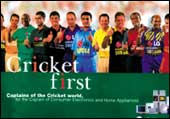|
Pick
up anything for Rs 65,'' screams the banner outside a makeshift
shop that's selling everything from electronic toys to moulded chairs
to footwear at Lajpat Nagar, a shoppers' borough in Delhi. Welcome
to one of the hundreds of ''Chaay-na" bazaars hoping to cash in
on the low-cost image of Chinese products. ''Not all products are
made-in-China. Most of them are produced in and around Delhi,''
admits Gaurav Mishra, a China Bazaar entrepreneur. The formula for
the quick buck is simple: scrounge the wholesale markets for cheap
deals and hire a place for two-weeks. The products can be Chinese
imitations, the B-model isn't.
-T.R. Vivek
SIDE EFFECT
Boom Checks In
 |
| Hotel industry: Something to cheer about |
The
rise of call centres isn't cheering young graduates alone. Hotels
too-at least the ones in Bangalore-are singing hosannas of the new
industry. Why? According to estimates, 15 to 20 per cent of the
1,100 five-star rooms in the garden city have been taken up by foreign
voice and technical trainers. These long-stay guests have made room
vacancy in the city drop to record low. Says Pep Kumar, General
Manager, Taj Westend: ''Typically, these guests stay with us for
anywhere between six weeks and six months.'' In appreciation, most
hotels reward them with 25 to 30 per cent discount on rack rates
and significant discount on other services like food and beverages,
laundry, and telecom. Despite the rush, the local industry is wary
of adding capacity, thanks to the new geo-political uncertainty.
Meanwhile, if you are travelling to Bangalore, book in advance.
-Venkatesha Babu
The
Other Korean War
Who won: The official sponsor or the ambush
marketer?
 |
| Rs 150 crore: That's their World Cup
ad-spend |
Cricket first
or India first? Actually, it was money first. as consumer durable
makers embark on the task of auditing the bang for their WC-ad bucks
it has become clear that there is a direct linear relationship between
the amount a company is willing to spend and returns in terms of
immediate sales, the trapping of official status be damned.
LG, the company with the official status, spent
close to Rs 75 crore on Cricket's biggest event. Samsung, despite
restrictions surrounding the use of Indian cricketers in its ads-the
result of an ICC effort to curb ambush marketing-burned close to
that amount, some Rs 70 crore. And while Samsung expects its March
2003 sales to be around the 100,000 mark, television industry execs
claim LG (the company wouldn't speak to Business Today) would do
around the same.
Being sponsor has its advantages-and we are
not talking about a mention in ICC President Malcolm Gray's speech
at the end of the tournament. By the end of the World Cup, LG boasted
a 54 per cent spontaneous ad recall among consumers across eight
metros according to an A.C. Nielsen study. Samsung did 37 per cent.
Still, that could well be a function of better advertising, not
an official status.
-Shailesh Dobhal
Bollywood's
'Hit'
A cold box office is hurting Hindi film
music sales.
The downturn in global music sales (down
from $34-billion in 2001 to $31-billion last year) seems to have
swept the Indian shores as well. The Rs 1,040-crore Indian music
industry, dominated by Hindi film music, has reported a 23 per cent
drop in sales. Piracy (which accounts for nearly 30 per cent in
lost sales) and higher acquisition costs apart, what seems to have
hit Indian industry the hardest is a weak performance by Bollywood
in 2002. With the box-office anything but hot in the first three
months of 2003, predictions are of no growth this year. A revival
is expected only around 2005. Shah Rukh had better get back.
-Swati Prasad
GULP
Fall
Brands
 Anytime
people in India go bashing the US, it's the country's two most visible
brands that get the most stick. No wonder, then, that recently when
the Andhra Pradesh-based People's War Group wanted to protest against
the American attack of Iraq (don't ask what PWG has to do with international
politics), they blew up a godown each of Pepsi and Coke in two different
locations in the state. May be the cola companies should start sending
the repair bills to the White House. Anytime
people in India go bashing the US, it's the country's two most visible
brands that get the most stick. No wonder, then, that recently when
the Andhra Pradesh-based People's War Group wanted to protest against
the American attack of Iraq (don't ask what PWG has to do with international
politics), they blew up a godown each of Pepsi and Coke in two different
locations in the state. May be the cola companies should start sending
the repair bills to the White House.
Why
Everyone Likes Biscuits
Wondering why the cookie refuses to crumble
when the entire fast moving consumer goods (FMCG) market is gasping
for growth? Here's our take: differentiation in terms of product
variants (chocolate chips and cream wafers are just the tip of the
iceberg) and aggressive distribution by mid-sized players like Priya
Biscuits may have helped, but the real reason for the double digit
volume growth in this category-and you'd better believe this-is
the pack.
No other category has adapted itself to smaller
pack sizes-something consumers prefer when things aren't going too
well with the economy at large-better than biscuits. ''There are
47 pack sizes in the biscuit market and a significant number (8)
of large pack sizes have been discontinued in the past two-three
years,'' says Sujit Das Munshi, Vice President & Executive Director
(Retail Measurement Services), A.C. Nielsen ORG-MARG. And most new
launches come in small sizes. Repeat after us: small is...
-Shailesh Dobhal
|

